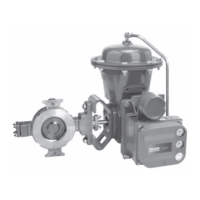8580 Valve
Instruction Manual
March 2010
9
If the packing is relatively new and tight on the shaft,
and if tightening the packing flange nuts does not
stop leakage, the shaft may be worn or nicked so
that a seal cannot be made. If the leakage comes
from the outside diameter of the packing, the
leakage may be caused by nicks or scratches
around the packing box wall. Inspect the shaft and
packing box wall for nicks and scratches when
performing the packing replacement procedures.
For valves with the ENVIRO-SEAL packing
system:
Optimum performance of the ENVIRO-SEAL
packing system is obtained when the Belleville
springs are tightened to their “target load.” The
target load is the point where the springs are
compressed to 85% of their maximum deflection, or
nearly flat. Maximum deflection is when the springs
are 100% compressed, or completely flat.
Under normal conditions, the packing nuts should
not require re-tightening. However, when servicing, if
the springs do not remain at the target load of 85%
compression, retighten the packing box nuts
according to the following procedure:
1. Tighten the packing flange nuts alternately and
evenly, keeping the packing flange parallel with the
valve flange (see figure 4), until the Belleville springs
are compressed 100% (or completely flat).
D For PTFE packing, loosen each packing
flange nut one half turn (180_ of rotation).
D For Graphite packing, loosen each packing
flange nut one quarter turn (90_ of rotation).
The target load of 85% compression has now been
reached. If leakage continues, replace the packing
components as described in the following
procedures.
Replacing the Packing
To replace the packing, the actuator must be
removed. Also, the valve should be removed from
the pipeline to allow proper readjustment of the disk
position.
WARNING
The edges of a rotating disk have a
shearing effect that may result in
personal injury. To help prevent such
injury, stay clear of the disk edges
when rotating the disk (key 3).
CAUTION
Damage to the disk (key 3) may occur
if the disk is not closed when the valve
is being removed from the pipeline. If
necessary, apply operating pressure to
the actuator temporarily to retain the
disk in the closed position while
removing the valve from the pipeline.
For valves with PTFE or graphite packing:
Key numbers in this procedure are shown in figure
10 unless otherwise indicated.
1. Isolate the control valve from the line pressure,
release pressure from both sides of the valve body,
and drain the process media from both sides of the
valve. If using a power actuator, also shutoff all
pressure lines to the power actuator, release all
pressure from the actuator. Use lock-out procedures
to be sure the above measures stay in effect while
you work on the equipment.
CAUTION
When removing the actuator in the
following step, use a wheel puller to
separate the actuator parts from the
valve shaft. Do not drive the actuator
parts off the valve shaft because this
could damage valve trim components.
2. Remove the actuator per instructions in separate
actuator instruction manuals, then remove the cap
screws and nuts (keys 35 and 36). Remove the
clamp (key 130, figure 3) if the strap (key 131,
figure 3) is used.
3. Remove the packing flange nuts and the packing
flange (key 26) if used and pull out the packing
follower (key 25).
4. Remove the anti-blowout ring (key 40) from the
drive shaft (key 10).
5. Remove the old packing rings (key 24) and, if
used, the packing washers (key 31). Carefully avoid
scratching the shaft or packing box wall to avoid
damage that could cause leakage around the shaft.
Clean all accessible metal parts and surfaces to
remove particles that would prevent the packing
from sealing.

